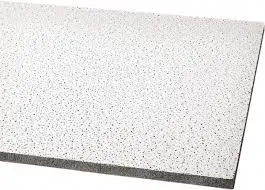Nov . 09, 2024 23:29 Back to list
Installing a Suspended Ceiling Tile Grid for Enhanced Room Aesthetics and Functionality
The Versatility and Appeal of Hanging Ceiling Tile Grids
Hanging ceiling tile grids have become increasingly popular in modern architectural design, both in commercial and residential settings. These grid systems not only provide a practical solution for concealing mechanical systems but also offer aesthetic benefits that enhance the overall ambiance of a space. In this article, we will explore the characteristics, advantages, and considerations for implementing hanging ceiling tile grids in various environments.
What Are Hanging Ceiling Tile Grids?
Hanging ceiling tile grids consist of a framework of metal or plastic channels suspended from the overhead structure, forming a grid-like pattern. This grid is then filled with ceiling tiles that can vary in material, size, and finish. Common materials used for these tiles include mineral fiber, gypsum, and acoustic tiles, which are designed to absorb sound and improve acoustics in a room.
One of the key features of hanging ceiling tile grids is their modularity. This allows for easy installation and replacement of individual tiles, which can be advantageous in environments where maintenance or updates are necessary. The tiles can also be customized in terms of color and texture to match the overall design aesthetic of the space.
Advantages of Hanging Ceiling Tile Grids
1. Concealment of Infrastructure One of the primary reasons for using a hanging ceiling tile grid is its ability to conceal ductwork, plumbing, and electrical wiring. These unsightly elements can disrupt the visual flow of a room, but the grid allows them to be hidden from view while still providing easy access for repairs or modifications.
2. Improved Acoustics Many ceiling tiles are specifically designed to enhance the acoustics of a space. Acoustic tiles absorb sound, reducing echo and improving overall sound quality. This makes hanging ceiling tile grids particularly beneficial in environments such as offices, schools, and auditoriums, where noise control is essential.
hanging ceiling tile grid

3. Aesthetics and Customization The variety of tile designs and textures available allows for a high degree of customization. Ceiling tiles can be chosen to complement the interior design, whether it be modern, traditional, or something in between. For example, sleek, metallic tiles can create a contemporary look, while decorative tiles can add a touch of elegance to a room.
4. Energy Efficiency Some ceiling tiles are designed to reflect light, which can help reduce the need for additional lighting in a space. This not only lowers energy costs but also contributes to a sustainable building design. Additionally, insulating tiles can improve the thermal performance of a building.
5. Cost-Effective The installation of hanging ceiling tile grids can be a cost-effective solution for finishing a space. Compared to traditional plaster and drywall ceilings, grid systems can often be installed more quickly and with less labor, resulting in lower overall costs.
Considerations for Implementation
While there are numerous advantages to using hanging ceiling tile grids, there are also several considerations to keep in mind. For instance, the height of the ceiling and the intended use of the space can impact the choice of grid system and tiles. In spaces with limited height, low-profile grid systems may be necessary.
Additionally, while the installation of ceiling grids can be straightforward, proper planning and execution are crucial to ensure a finished product that meets safety and aesthetic standards. It is advisable to work with experienced professionals to assess your specific needs and challenges.
Conclusion
Hanging ceiling tile grids offer a versatile solution for improving both the functionality and aesthetics of various spaces. By providing opportunities for customization, sound absorption, and infrastructure concealment, these systems have become a preferred choice in many design projects. As trends in interior design evolve, the use of hanging ceiling tile grids will continue to adapt and thrive, ensuring that they remain a relevant and appealing option for builders and designers alike. Whether in a corporate office, a classroom, or a residential home, these grids can transform any environment into an elegant and efficient space.
-
Durable Ceiling T Grid Systems | Easy InstallationNewsAug.29,2025
-
PVC Gypsum Ceiling: Durable, Laminated Tiles for Modern SpacesNewsAug.28,2025
-
Pvc Gypsum Ceiling Is DurableNewsAug.21,2025
-
Mineral Fiber Board Is DurableNewsAug.21,2025
-
Ceiling Tile Clip Reusable DesignNewsAug.21,2025
-
Ceiling T Grid Modular DesignNewsAug.21,2025







